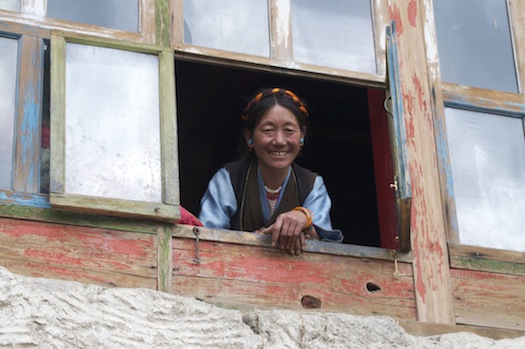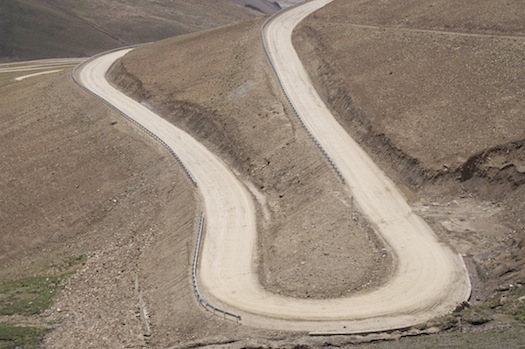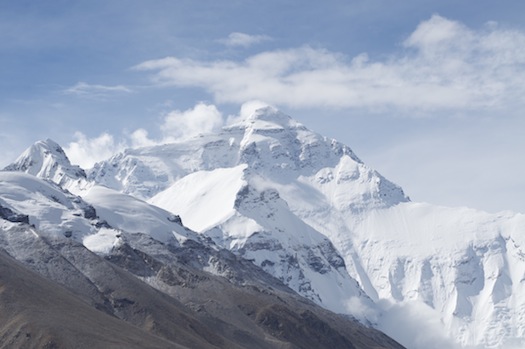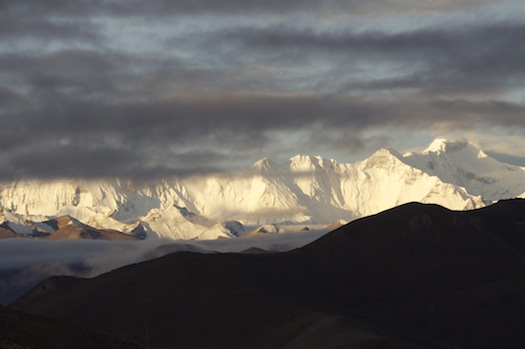The Last Few Miles Are the Most Difficult, but the View is Worth It

August 31, 2010
I disappeared. I disappeared from the blog, I disappeared from work, and I disappeared from everything else for thirteen days. (Thanks to all of you who were kind enough to email me, call me, and direct message me to make sure nothing happened to me!)
A few months ago, I was offered a chance to visit Lhasa, Tibet and Shaghai, China with some friends. While planning our journey, one member of our group noted that, while we were so close to Mt. Everest, we should make the trip to Base Camp 1 at 17,000. We did the research, made the arrangements, and made the trip.
No doubt I will be using what I learned from this trip for some time to come. Some of the pictures I took tell an amazing story. But this metaphor is one of my favorites: the last few miles are often the hardest, but it is the only way to get the view, and the view is worth the effort.
To reach Everest, you have to travel across the Tibetan countryside for days. You literally have to cross over mountains with very little (or nothing) separating you from the edge on a road littered with obstacles like rockslides, livestock, and other drivers to whom lanes mean nothing. Crossing these mountains takes you to elevations almost as high as Basecamp, some as high as 16,600 ft. above sea level. A short walk from the car can leave you breathless, and you can expect to be awakened in the middle of the night gasping, for no other reason than the air is so thin.
Driving to Everest isn’t a trip you can or should make in a single day. To make the trip, you have to allow your body to acclimate to the high altitude. So your journey requires that you stay in the little towns between Lhasa and Mt. Everest for a few days, gradually climbing higher into the altitude. The best hotels you can you find will serve food that, should you be willing to eat it, will likely result in making your trip more difficult. The air quality is poor, and the countryside is dusty, and you’ll know this to be true even standing inside your hotel room.
The best accommodations won’t resemble anything that you are used to, even though the Tibetan people are sweet and generous, and even though they will offer you the best of everything that they have to offer.
But the last 60 miles is the toughest traveling. Once you leave Shegar, the last small town between you and Everest, you are off paved roads. You’ll travel up and over mountain passes that have never been paved, on roads that switch back dozens of times with nothing between you and the edge. The road is rough, and even the suspension on your four-wheel drive won’t do much to make traveling over the uneven earth easier. In many places, your guide will go completely off the road, knowing that it is both smoother and safer.
You make this trip not knowing what the view you will be like once you get there. If there is bad weather, you will see very little of Everest, even from Base Camp. If it is windy, the highest mountain on earth may be completely covered with clouds. Some stay for days and never see what they traveled so far to see. But if you make the journey, and if you have a little luck on your side, the journey ends with a breathtaking view that is provided to the few that are willing to make the journey.
What does any of this have to do with sales?
The Mountain Doesn’t Come to You: To Get the View, You Have to Make The Journey
The distance between you and your biggest dream client is great. The journey is not going to be easy, and the road that you have to travel over to win your dream client can sometimes be the most difficult and challenging road you will ever face. But to get there, you have to make the journey.
The mountain doesn’t come to you. It doesn’t come to anyone. Those that experience the mountain make the journey.
What Is Easier Down Low Is Harder at Altitude
Working on smaller, more transactional clients does nothing to prepare for you for what you face when pursuing giants. What may be very easy and very natural to you as you call on clients at one level may become incredibly difficult as you move higher (sleeping and breathing is easy at sea level, it is something altogether different at 15,000 ft.).
You may not rely on your sales process to win smaller clients. You may even win some deals after violating the iron laws of sales. But when you climb higher, you will find that what works at one level doesn’t work at all as you move higher. A half-assed needs analysis may get you by on transactional deals and may cost you your deal as you pursue your dream clients.
To survive and thrive and altitude, do what those who live at altitude do. They follow the rules, and they are happy to share them with you. They go a little slower. They do what they know to work most often. They put themselves in a place to succeed.
The Last Few Miles Are the Hardest. Make a Way.
The last few miles pursuing your dream client are often where the road gets both dangerous and bumpy. You run across challenges that you have never before encountered, and you often find yourself way off anything that resembles your road map.
If you have done everything right to get to the final stages, the last few miles can often be where deals are won and lost. Navigating the rough terrain, selling inside, going off the roadmap, and negotiating the terrain are all part of getting there. You may be physically tired, and you may be out of your element, but the end game is where you will be tested.
The challenges of winning increase as your deals get larger. Sometimes there is no road. Being a professional salesperson—and winning—means making a way where none exists.
Even If You Lose
Some people sleep in tents at Base Camp so that they have every possible chance to see Mt. Everest. Their determination and perseverance are sometimes rewarded. But the smart people make the journey knowing that even if they don’t get the outcome they were seeking, that the journey provides them with the growth, the experiences, and the stories.
It is best to journey to Everest when you have the greatest chance of a clear view. But sometimes, you have to go when you have the opportunity. The same is true of pursuing your dream clients: while it is nice to have favorable conditions, you have to make your attempt when you can—even if the conditions aren’t favorable.
And you have to love the journey—even when the road is rough and even when you don’t get what you came for.
Conclusion
Winning your big deal dream clients is a journey. The end game can often be the most difficult part of the journey. But if you would win, you have to make the journey.
Questions
-
- What is your Mt. Everest? Who is your Mt. Everest? Have you started on your journey? Are you making the attempt that you need to make in order to win your dream client? Or, are you waiting for the mountain to come to you? When will you start your journey?
-
- Do you recognize that what may work at one level may become a liability at a higher level? Do you recognize that those who perform at a higher level have rule-sets that they follow that allow them to succeed at that level? Are you studying those rule-sets? What discernments are you making about what you do and what those who live and breathe at a higher level are doing? Who are you studying?
-
- Are you willing to go off the roadmap and make way to get there with your dream client? Are you comfortable being uncomfortable? What are you willing to do to move obstacles, to navigate over and around them when necessary? What are you doing now to make a way? What should you be doing?
- What do you have to do to love the journey? What are you gaining from your experiences? What lessons are you learning and how are you applying these lessons to your future deals? How are you applying what you learn to your life? How do you get the most from losing?
For more on increasing your sales effectiveness, subscribe to the RSS Feed for The Sales Blog and my Email Newsletter. Follow me on Twitter, connect to me on LinkedIn, or friend me on Facebook. If I can help you or your sales organization, check out my coaching and consulting firm, B2B Sales Coach & Consultancy, email me, or call me at (614) 212-4279.
Read my interview with Tom Peters (Part One and Part Two).
Read my Blogs.com featured guest post on the Top Ten Sales blogs.
Read my monthly post on Sales Bloggers Union.
Get The Sales Blog iPhone App to read The Sales Blog and Twitter Feed on your iPhone.














